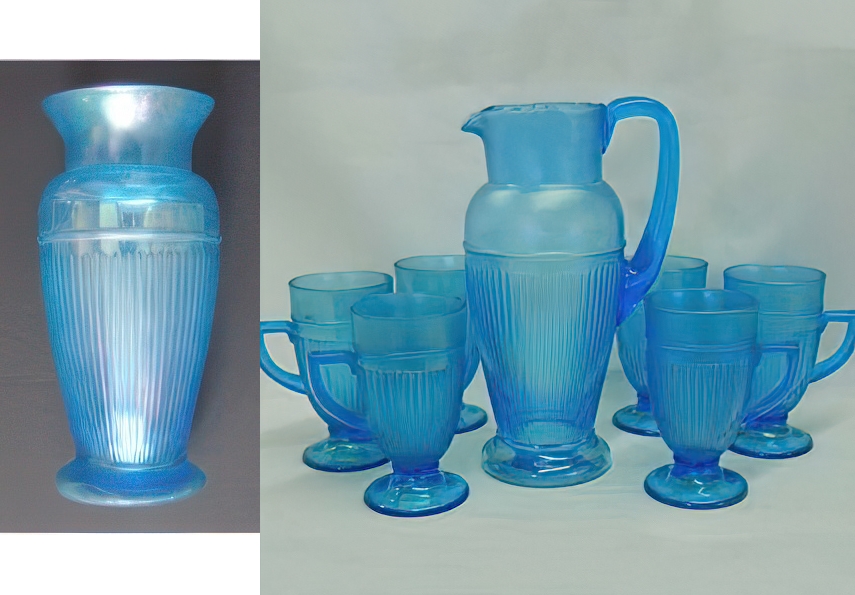Adam’s Rib
by Barb Chamberlain
Adam’s Rib isn’t an easy pattern to find. It was first produced by the Diamond Glass Company beginning in 1925 to bridge the gap between carnival glass and stretch glass. It was #900 in the Diamond Company catalog. It has a pattern, of course, so it can be considered a carnival glass pattern, but has the stretchy finish to make it stretch glass. The pattern consists of ribs that extend up from the bottom of the piece about two-thirds of the way with a plain band along the top portion of each piece. The pattern is on the exterior of the pieces.
The shapes found are a lemonade pitcher with handled tumblers or mugs, handled sugar and creamer, compotes in several shapes, hollow candleholders, a flared or fan shaped vase, a bulbous vase, large console bowl, and pedestal footed bowl. Dave Shetlar also shows a covered candy dish, a compote flared from that candy base, cup, and bowl sitting on a flat base. A shape that was surprising to me, on the Shetlar site, was an eight-inch plate with a pedestal stand. Dave Doty shows one on his website that has a bit larger diameter, most likely it was flattened a bit more than the one on Shetlar’s site.
Carnival Glass 101 reported that Rick Kojis once had listed a celeste Adam’s Rib juice glass on eBay some time ago. It measures three and one-half inches tall. This did not have a handle.
Compotes can be found in several shapes, including bowl shape, flared, flared with a rolled rim, and ice cream shaped. There is also a rolled rim compote made from the candy base in marigold on milk glass, which would naturally not be as large as the usual compotes. Would that compote made from the candy dish be a whimsey, and if so, is it the only one known? The large compotes measure about eleven inches in diameter.

On the right is the scarce marigold on milk glass compote. Although none are easy to find, celeste blue is a more common color, on the left, in Adam’s Rib.

Pictured above is an ice green rolled edge compote.
Colors most commonly seen in this pattern are ice green and celeste. Seeck Auctions sold a marigold on milk glass compote and a pair of candlesticks. From what I have read, marigold on milk glass and marigold are both rather uncommon in the Adam’s Rib pattern. Dave Shetlar shows a flared bowl in marigold on milk glass.

Above is a very nice pair of candlesticks in marigold over milk glass.
The large nine and three-fourths inch bulbous vase is celeste, and so is the one pictured on the Shetlar site. Are there other colors known? The other style vase has a pedestal foot with stem-like glass that flares out at the top. These come in two sizes (both pictured in celeste on Shetlar’s site): nine and twelve inches tall. Some reports mention that there is a fan vase, but it appears to me to flare to a rounded top on the Shetlar site, but with glass, you don’t know if there was a vase that was flattened to a fan vase also. At any rate, it cannot be too common.

It appears that the bulbous vase, left, and the water pitcher, right, were most likely made from the same mold. Note that handled mugs complete the water set.
A celeste blue cup whimsey appears on the Shetlar site. Apparently, someone thought that a ruffled nappy would be a nice piece to make. A crystal cup is also found on that site. I presume that it has iridescence. That is the only piece pictured in crystal.

Above are two pieces of Adam’s Rib in ice green; a creamer and handled mug.
Are there other shapes known? Are any of the shapes that I have mentioned found in any other colors? If so, please send me photos and information to dbcham@iowatelecom.net or 124 E. Honey Creek Dr., Manchester, IA 52017. I’m sure our readers will find any additional information very interesting.
Photos courtesy of Seeck Auctions and the editor.
This article first appeared in the ICGA Pump in the March 2018 issue and is reprinted with permission.
